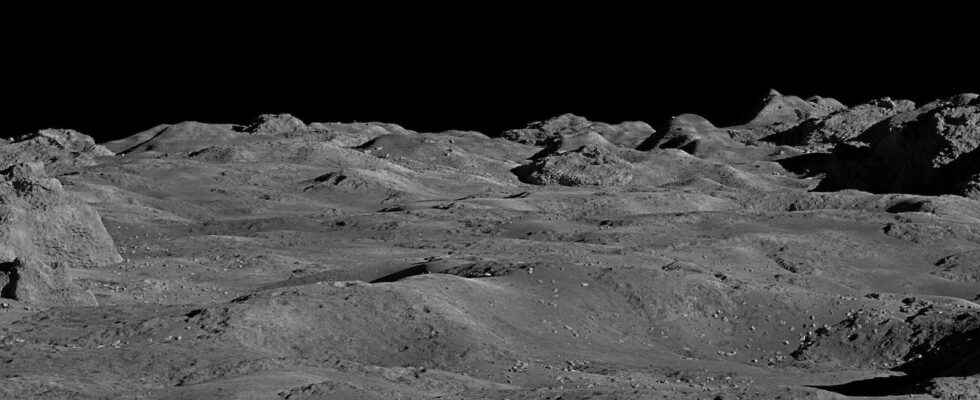You will also be interested
[EN VIDÉO] Apollo program: where are the landing sites on the Moon? For each Apollo mission, NASA selected two landing sites. These are therefore 14 sites that will have been screened before sending astronauts to land there. This selection was not an easy task for NASA, which had to find a compromise between ease of access, mission security and scientific feedback. Our explanations.
One of the objectives of the various Apollo missions was to bring back as many samples of the lunar soil as possible to study the history of our satellite. In 1971, Apollo 14 mission site was thus particularly chosen for its geological interest. In sight: the geological formation of Fra Mauro, a chaotic region located west of the crater of the same name, located in the immense basin of the Rains (Imbrium basin). This vast area of 1,300 kilometers in diameter, identified in 1893 by Gilbert, is one of the main structures marking the surface of the lunar landscape. It is interpreted as the largest impact basin on the near side of the Moon. In matter in size, the Pluies basin is followed by the Crises basin (Crisium basin), older, and the Oriental basin, younger. Both are also associated with impacts that occurred during the period of the Late Heavy Bombardment. The objective of Apollo 14 was therefore to land as close as possible to the supposed center of the impact.
A major impact making it possible to date many other craters
During the formation of the Rains Basin, a huge amount of debris would have been scattered all over the surface of the Moon. This debris has been studied for a long time, thanks in particular to observations at telescopebut also thanks to the rocks brought back by the various Apollo missions. Quickly, the scientists discovered that the various lunar samples taken during the different missions showed a similar composition and an age of 3.92 billion years. The idea that all these rocks were scattered debris from the impact that formed the Rainy Basin therefore quickly took hold. This made it possible to date the formation of the basin itself, but not only. Because the precise dating of this impact, and of the ejecta, also made it possible to establish the age of many other formations and craters everywhere on the surface of the Moon.
On the basis of spectral analyzes and new images of the lunar surface, a team of scientists from the University of Oslo, however, calls this interpretation into question.
Analyzing the composition of the lunar soil from space
To achieve this, the researchers analyzed the reflected light by the surface of the Moon. The decomposition of this light into several wavelengths makes it possible to know which minerals lunar rocks are formed, and that from space. Spectral analysis of the Apollo 14 landing site thus reveals that it is not only composed of ejecta from the Rainy Basin. The ground would actually be covered with two levels of rock, the most superficial of which would be composed of ejecta from another, much younger basin: the Orientale basin.
The majority of the samples taken by Apollo 14 would therefore not come from the Pluies basin, but from the Orientale basin. And that totally changes the situation! First, these results, published in The Planetary Science Journal, imply a new age for the impact of the Oriental basin, which would therefore be 3.92 billion years old, or 200 million years older than previously assumed. Domino effect, the Pluies basin, whose ejecta make up the deepest level, would therefore be even older. This modification therefore requires an adjustment of the ages of a large part of the lunar surface. Second, the study involves a reinterpretation of the chronology of certain events, including the beginning of the phase of volcanism (which will give rise to the different “seas”) which would thus coincide with the impact in the Eastern basin.
A meteorite bombardment less intense than expected
All of these results lead to a revision of the thermal history of the Moon and suggest that the meteoritic bombardment that occurred around 3.9 billion years ago would have been of lower intensity than previously assumed. This hypothesis is very important for the considerations of habitability of the primitive Earth, which underwent the same bombardment, at the same time. In other words, the situation would have been less catastrophic than we thought.
Support an editorial team committed to popularizing science on Patreon!
Our mission ? Return the knowledge accessible to everyone.
We produce our own articles, investigations and reports every day, all on a human scale. Support us in this approach and this ambition.
Subscribe to Futura on Patreon!
Two subscription plans are available to you with the following advantages:
- ” Futura ad-free »: get guaranteed ad-free access to the entire site for €3.29/month (+VAT).
- ” I participate in the life of Futura »: in addition to access without advertising, take part in the life of our independent media (votes, new content, surveys, etc.) for €6.29/month (+VAT).
Interested in what you just read?
